Skiing gear rentals should match your ability level, from beginner-friendly shorter skis to advanced performance equipment. First-timers benefit from complete packages with properly fitted boots, while intermediate skiers need gear that supports parallel turns on blue runs. If you have mobility challenges, specialized equipment like outriggers or sit-skis can enhance your experience. Visual or cognitive impairments? Adaptive programs offer communication systems and tethering options. The right rental transforms your mountain adventure.
Assessing Your Current Skiing Ability Level
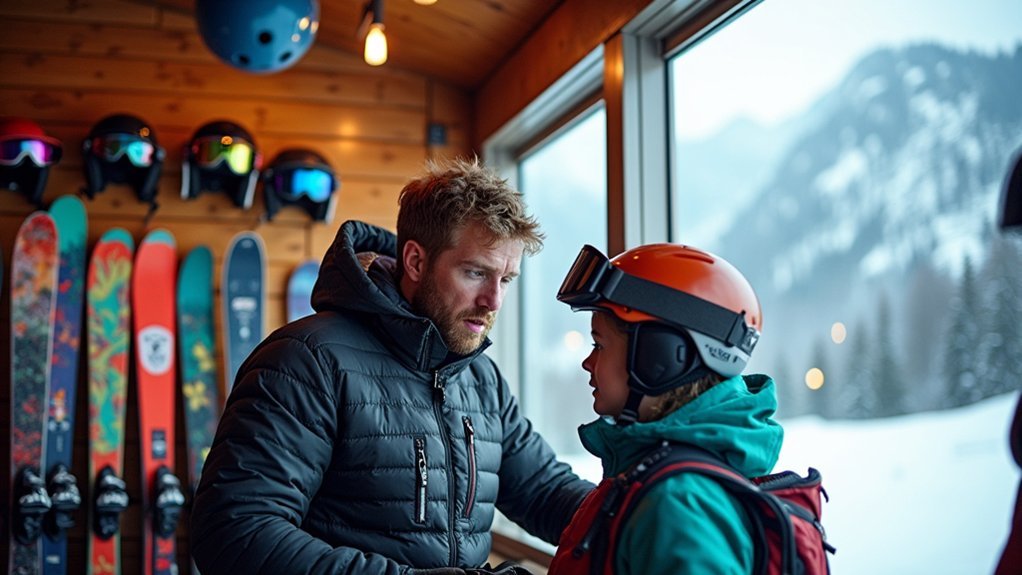
Before renting ski equipment, you’ll need to accurately assess your skiing ability to guarantee you get gear that matches your skills.
Consider how confidently you navigate different terrain types and your comfort with speed control.
Beginners typically prefer gentle green slopes and focus on mastering basic stopping and turning techniques.
If you’re intermediate, you’ll likely execute parallel turns on blue runs and might be exploring easier black slopes or introductory off-piste areas. Level 6 skiers have gained the ability to ski confidently with parallel turns on all groomed blue terrain.
Advanced skiers consistently perform parallel turns on black runs and confidently tackle bumps, trees, and powder.
Experts can handle any terrain with precision, maintaining control at high speeds in challenging conditions.
Be honest about your abilities—overestimating skills could lead to inappropriate gear that hampers your enjoyment and progress on the mountain.
Rental Options for First-Time Skiers
First-time skiers should look for beginner packages that include shorter, softer skis for easier control on simple slopes.
You’ll need properly fitted boots that feel snug but not painful, as they’re essential for transferring movement to your skis.
Most rental shops provide complete setups with skis, boots, and poles in one convenient package, saving you the hassle of piecing together individual items. Don’t forget to tell staff about your height, weight, and age so they can recommend appropriate gear for your body type and experience level.
Beginner Ski Packages Explained
Three key components make beginner ski packages an ideal starting point for new skiers: convenience, affordability, and appropriate equipment selection.
Most resorts offer these packages close to the lifts, typically including skis, boots, poles, and optional helmets starting at $50-70 daily.
When you arrive, rental staff will assess your height, weight, and skill level to guarantee proper sizing. They’ll help you select equipment designed specifically for stability and ease of use, making your first skiing experience more enjoyable. Beginner equipment is designed for easy maneuverability and confidence on groomed runs.
For added comfort, you can rent accessories like goggles and gloves.
If you’re planning multiple days on the slopes, ask about multi-day discounts. Many resorts also offer package deals that bundle rentals with lessons or lift tickets, providing additional value for first-timers.
Boot Fit Essentials
Proper boot fit serves as the foundation of your entire skiing experience, determining both comfort and performance on the slopes.
As a first-timer, you’ll encounter the Mondopoint sizing system, which measures your foot length from heel to toe.
When renting boots, prioritize a standard fit that offers comfort while maintaining necessary support. Look for beginner-friendly options with softer flex and simpler lacing systems that forgive mistakes while you learn.
Since rental shops typically don’t offer half sizes, you might need adjustments with liners for an ideal fit. Remember to select boots that are closest to your dress shoe size, not your athletic shoe size.
Don’t rush this process. Have a professional help with your fitting, and try several pairs before deciding.
Consider your foot width and volume beyond just length.
Simple Slopes Setup
When starting on your first skiing adventure, renting a complete equipment package offers the simplest path to enjoying the slopes without a significant upfront investment.
Look for basic packages that include shorter, softer skis that enhance control and stability as you learn. Rental staff will match your equipment to your height, weight, and ability level, ensuring you’re comfortable and confident.
Don’t skip on safety gear—helmets are essential, while goggles protect your eyes from glare and snow. Consider pre-booking your equipment online to save time and potentially money.
Remember that beginner-specific skis are designed for easier turning and stability, helping you progress faster. As a first-timer, you’ll likely be fitted with Standard equipment, which is perfect for beginners and intermediate skiers learning the basics.
Most resorts offer on-site rentals, making it convenient to get fitted and make adjustments as needed throughout your day on the slopes.
Adaptive Equipment for Mobility Challenges
If you’re renting adaptive equipment for mobility challenges, you’ll find various sit-ski options including mono-skis, bi-skis, and tri-skis to match your specific needs and ability level.
When selecting outrigger gear, consider whether you need fixed or adjustable models, which provide essential balance support while maneuvering the slopes.
These specialized rentals typically come with fitting assistance from trained staff who’ll help guarantee your equipment offers the right combination of stability, control, and comfort for your skiing experience. Tri-skis are particularly valuable for beginners as they provide enhanced stability for individuals with decreased balance and coordination.
Sit-Ski Technologies
Adaptive skiing opens winter sports to everyone through specialized sit-ski equipment designed for those with mobility challenges.
You’ll find several options to match your abilities and goals.
Bi-skis offer maximum stability with bucket-style seating and two skis underneath—perfect for beginners. If you have stronger upper body strength, mono-skis provide more independence with a single ski attachment.
For intermediates, the Bi-Unique delivers a lower center of gravity with its unique glove seating system that hugs your body securely.
Many models feature adjustable components to customize seat angles and heights. Metal edges improve your control on snow, while front-mounted suspension systems like those in the Dynamique create a smoother ride.
Most equipment includes practical features like footplates, shoulder straps, and tethering options for additional support. The Snow’Kart provides an excellent alternative for individuals who lack upper body strength but still want to experience the thrill of skiing.
Outrigger Gear Selection
Outriggers serve as essential companions for adaptive skiers, providing the stability and control needed to traverse slopes confidently.
When selecting outrigger equipment, you’ll want to take into account your specific mobility needs and skiing style.
- Versatility matters – Look for models that support both seated and standing positions if you alternate between skiing styles.
- Weight considerations – Lightweight materials reduce fatigue during longer ski sessions.
- Attachment options – Velcro straps offer secure grip while maintaining comfort around arms.
- Adjustability features – Confirm height adjustments accommodate your body proportions.
- User-specific designs – Different conditions (amputations, spinal injuries, MS) benefit from specialized configurations.
Whether you’re managing balance challenges or maneuvering with prosthetics, rental facilities offering Superlite Outriggers or Enabling Technologies equipment can match you with appropriate adaptive gear. Quality outriggers assist skiers with balance and turning while also providing help with stopping and lift access.
Specialized Ski Gear for Visual Impairments
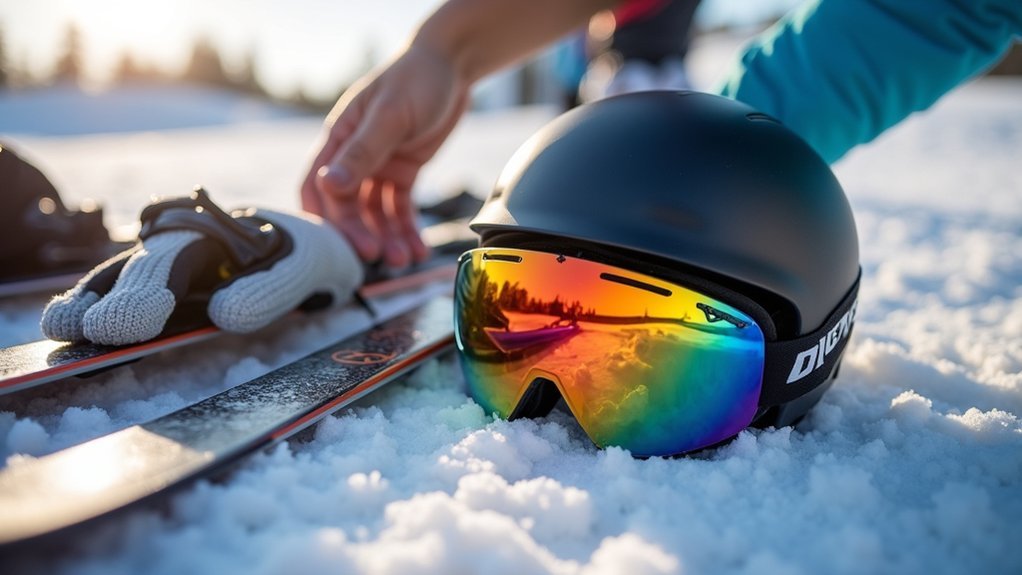
Visual impairments don’t need to limit your skiing experience, thanks to innovative equipment designed specifically for low-vision and blind skiers.
You’ll find headset and two-way radio systems that facilitate continuous communication with your guide as you navigate down slopes.
Outriggers, similar to white canes, provide essential balance and navigational support. For safety and visibility, you’ll wear brightly colored reflective vests that alert other skiers to your presence on the trail.
Many rental services like Oregon Adaptive Sports and The Unrecables offer specialized equipment tailored to your visual needs. These radio systems ensure clear directional guidance between skiers and instructors throughout your runs.
Training aids such as bamboo poles help you develop technique while guided skiing guarantees your safety.
Most importantly, you’ll use much of the same standard equipment as sighted skiers, with thoughtful adaptations that make skiing accessible and enjoyable.
Equipment Considerations for Cognitive Disabilities
When approaching skiing with cognitive disabilities, you’ll find that the right equipment adaptations can make all the difference in your experience on the slopes.
Rental shops often provide specialized gear designed to enhance safety and learning while accommodating your cognitive needs.
Specialized rental equipment opens skiing possibilities for all minds, bridging cognitive differences with thoughtful adaptations.
Look for these essential adaptive equipment options:
- Tethering systems that allow instructors to guide your movements and control speed
- Adjustable outriggers providing extra balance support when needed
- Specialized ski stems that can be customized to your learning style
- Visual or tactile indicators on equipment to reinforce verbal instructions
- Adaptive bindings that accommodate both cognitive and physical requirements
These adaptations work alongside standard skiing equipment, with trained staff available to help you select gear that matches your abilities and maximizes your skiing enjoyment while maintaining safety. Remember that adaptive skiing instructors will assess your specific needs before recommending the most appropriate equipment setup for your lesson.
Sit-Ski Rental Options and Fittings
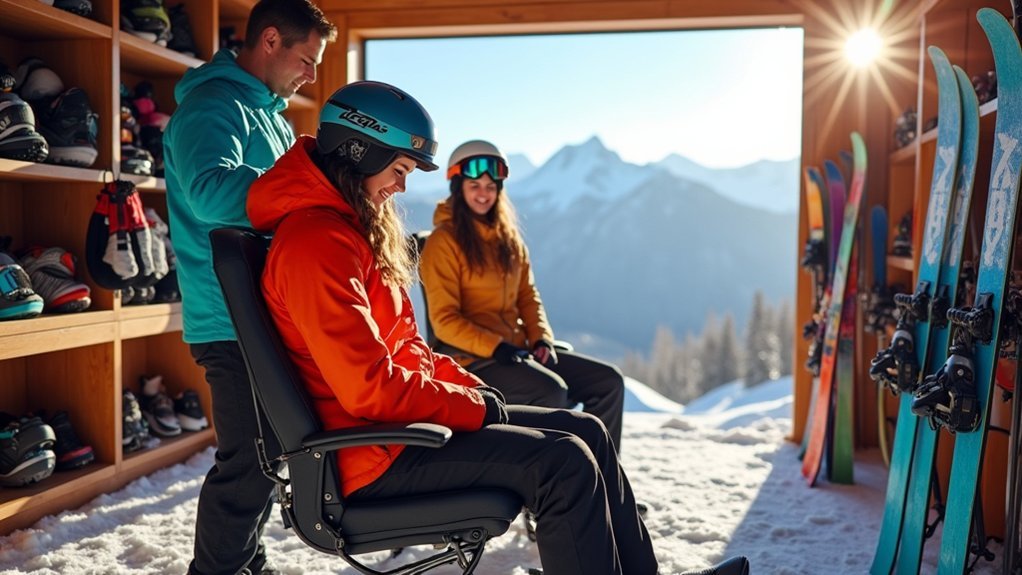
When renting a sit-ski, you’ll find various adaptive equipment options tailored to your specific needs, including bi-skis with articulating mechanisms and essential accessories like outriggers.
Your comfort and safety depend on proper fitting, which requires scheduling an appointment where specialists will adjust the seat width and guarantee you stay within the frame’s recommended limits. The full sit-ski package costs $125.00 and includes outriggers and a helmet.
The type of sit-ski you choose should match your intended terrain, with high-performance models like the Mega III Apres suited for experienced skiers tackling more challenging slopes.
Customized Sit-Ski Adjustments
Finding the right sit-ski equipment requires personalized attention to guarantee maximum comfort and control on the slopes.
Most ski resorts offer specialized sit-ski rentals with professional fitting services to verify your equipment matches your specific needs and abilities.
When you visit a rental shop for a sit-ski, you’ll typically receive:
- An initial assessment to determine the appropriate sit-ski style for your condition
- Customized adjustments to seating position for ideal balance and support
- Professional guidance on equipment features designed for your skiing style
- Safety instructions and proper handling techniques before hitting the slopes
- Ongoing support for any necessary readjustments during your skiing experience
These personalizations are essential for building confidence and making sure you’ll have a safe, enjoyable adaptive skiing experience. Technicians will ensure your sit-ski has proper heel restraint when flexing to maintain stability and control during your runs.
Adaptive Equipment Choices
Choosing the right adaptive skiing equipment can transform your mountain experience from challenging to exhilarating. Sit-skis, mono-skis, and bi-skis offer different levels of support based on your specific mobility needs. Most are chairlift-compatible, expanding your access to various terrain.
Before renting, you’ll need to participate in lessons or demonstrate proficiency with the equipment. Professional fitting is essential—experts will adjust your sit-ski to guarantee proper positioning, comfort, and control. Mono Skis & Ski Bikes are available daily from 9am-4pm and require proper fitting and assessment before use.
You’ll also need to show you can independently load and unload from chairlifts.
Many organizations like USARC and the National Ability Center offer extensive rental packages including equipment, instruction, and lift access. Costs vary by location, but some programs provide financial assistance to make adaptive skiing more accessible.
Sit-Ski Terrain Compatibility
Sit-skis excel on various mountain terrains, though each terrain type presents unique challenges and opportunities for adaptive skiers.
When renting equipment, you’ll need to evaluate where you plan to ski and your experience level. Rental facilities often provide guidance on terrain compatibility based on your abilities.
- Groomed runs offer ideal conditions for beginners and experienced sit-skiers alike, providing smooth surfaces for learning and practicing. Most modern sit-skis include shock absorbers that significantly enhance rider comfort on these smooth surfaces.
- Powder and steeps become accessible with proper technique and experience—ask about shock absorbers for better handling.
- Tree skiing demands quick reflexes and excellent control—evaluate more maneuverable mono-ski options.
- Moguls require precise movements and agility—rentals with specialized suspension can help.
- Backcountry terrain necessitates careful assessment—ensure your rental equipment includes appropriate safety features.
Outrigger Selection for Balance Support
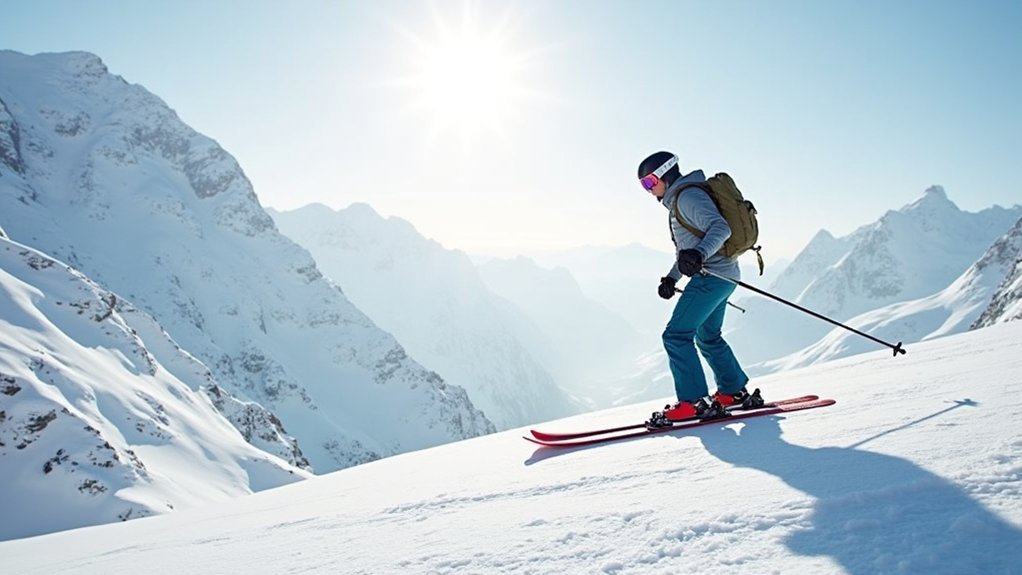
When selecting outriggers for balance support, you’ll need to evaluate both your skiing ability and specific mobility needs.
Consider lightweight aluminum adjustable outriggers that can be customized to your height and skiing style, providing ideal control and maneuverability on the slopes.
For three-track skiing (one ski with two outriggers), look for models with flip-ski designs that allow vertical movement of the ski tip for flexible turns and stops.
If you’re using four-track skiing techniques, standard outriggers offer excellent stability while maintaining control.
Don’t hesitate to seek advice from adaptive skiing professionals at rental shops who can guide you toward the right configuration.
Proper sizing is essential—outriggers should complement your height and strength to effectively assist with balance, turning, and speed control on various terrains.
For sit skiers with muscle weakness or amputations, specialized Superlite Outriggers models are available that attach directly to adaptive equipment.
Mono-Ski vs. Bi-Ski: Choosing Your Setup
How do you decide whether a mono-ski or bi-ski is right for your alpine adventure? Your physical abilities and skiing experience should guide your choice.
Mono-skis offer greater maneuverability with a single ski base, ideal if you have strong core strength and arms. Bi-skis provide more stability with two skis, making them perfect for beginners or those needing additional support.
Choose equipment that matches your body’s capabilities — mono-skis reward core strength with agility, while bi-skis offer reassuring stability for newcomers.
- Mono-skis require more balance but deliver enhanced agility for advanced terrain.
- Bi-skis can be tethered to instructors for safety and control assistance.
- Your upper body strength will determine comfort—stronger skiers often prefer mono-skis.
- Consider your progression goals—many skiers start with bi-skis before advancing to mono-skis.
- Both options use bucket-style seats and outriggers for balance, but with different control techniques.
Twin skis are another option that combines elements of both bi-skis and mono-skis, offering both performance and stability.
Adaptive Pole Options for Different Needs
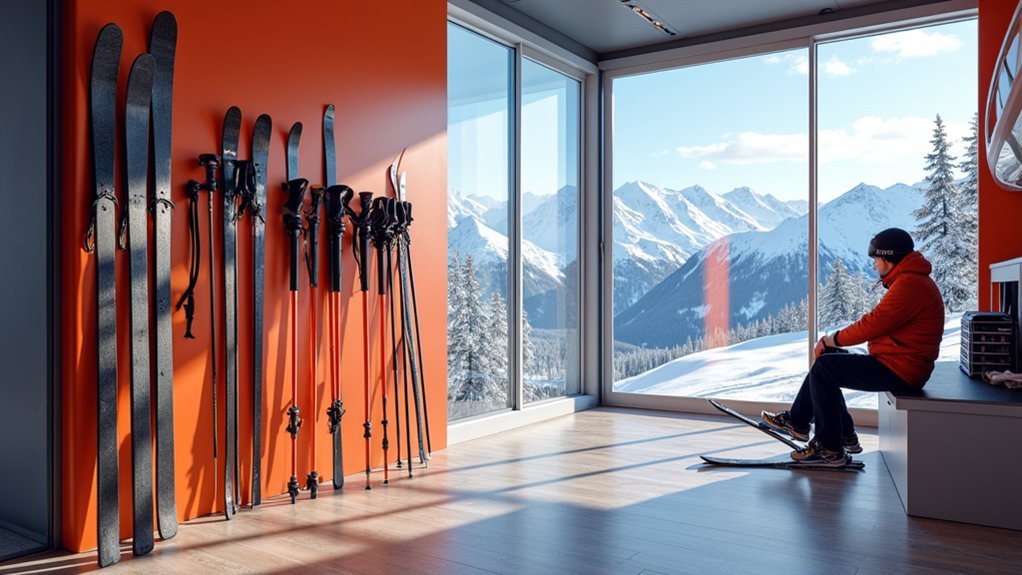
Selecting the right adaptive poles can transform your skiing experience from challenging to exhilarating. Fixed outriggers with small attached skis offer lateral stability if you have moderate balance impairments while still retaining some standing ability.
If you need support for limited hand strength, consider handheld adjustable poles with specially designed grips or cuffs. For those requiring additional assistance, tethered poles allow instructors to control your speed and direction from behind.
Skiers with grip strength limitations benefit from outriggers with ergonomic handles, featuring anatomical shapes and securing straps. Three-track skiers typically use outriggers with one ski and two poles for maintaining balance while skiing on their remaining leg.
If you’re interested in Nordic sit-skiing, specialized longer poles with adapted straps can help you generate momentum using upper body strength.
Your rental specialist can help match pole options to your specific abilities and skiing goals.
Boot Modifications and Custom Fittings
Five essential modifications can transform rental ski boots from uncomfortable torture devices into personalized performance equipment.
Even at rental shops, you’ll find options to customize your boot fit for better performance and all-day comfort.
- Custom insoles distribute pressure evenly across your feet while providing proper arch support to reduce fatigue.
- Heat-molded liners conform precisely to your foot shape, eliminating painful pressure points and improving warmth.
- Shell modifications like stretching or punching can accommodate wider feet or bone spurs without compromising performance.
- Buckle and cuff adjustments optimize alignment with your leg’s natural angle for better power transfer.
- Strategic padding addresses specific pressure points and helps fine-tune the boot volume to match your foot dimensions.
Proper adjustments to ramp angle and forward lean can significantly improve your fore/aft balance while skiing.
Don’t hesitate to ask your rental technician about these customization options—they’re often included in premium fitting services.
Rental Programs With Trained Adaptive Instructors
While boot customization enhances your personal comfort, access to specialized instruction can open the world of skiing to everyone. When choosing an adaptive rental program, look for facilities staffed with PSIA-AASI certified instructors who’ve completed rigorous training in adaptive teaching methods. The best instructors maintain their expertise by earning six CEUs annually through various educational opportunities including clinics and online webinars.
| Program Feature | What It Means For You |
|---|---|
| Certified Instructors | Confidence in safe, effective instruction tailored to your needs |
| One-on-One Lessons | Personalized attention focused on your unique abilities |
| Extensive Equipment | Access to specialized gear matched to your specific requirements |
| All-Ages Approach | Family-friendly instruction for everyone age 7 and up |
These specialized programs offer more than equipment—they provide therapeutic benefits while building self-confidence through customized instruction. Many resorts now offer introductory adaptive lessons with properly trained staff who understand both the technical and emotional aspects of adaptive skiing.
Cost Comparison of Adaptive Skiing Equipment Rentals
The substantial cost of adaptive ski equipment presents a major hurdle for many winter sports enthusiasts with disabilities.
Pricey adaptive ski gear creates a significant barrier for disabled winter sports lovers seeking slope access.
With specialized gear like monoskis and bi-skis costing between $5,000 and $15,000 to purchase, rentals become the most practical option for most skiers.
You’ll find significant price variations across rental locations that can help you manage your budget:
- Off-site rentals can cut costs by up to 50% compared to slope-side options
- Many adaptive programs include equipment in their lesson packages
- Booking in advance often secures better rates and equipment availability
- Northern Utah and Hillsdale, NY offer competitive rental options with various equipment types
- Epic Mountain Rewards members can access additional discounts at participating locations
Organizations like the National Ability Center in Park City offer rental costs ranging from $15 to $45+ with scholarships available for those who need financial assistance.
Planning Your Mountain Visit With Adaptive Equipment
Successfully planning a ski trip with adaptive equipment requires thoughtful preparation beyond what typical skiers might consider. You’ll need to coordinate equipment availability, lessons, and accessible lodging well in advance.
| Planning Element | Consideration | Why It Matters |
|---|---|---|
| Equipment | Reserve specific gear (mono/sit skis) | Guarantees availability for your needs |
| Instruction | Book personal instructor | Provides specialized guidance |
| Lodging | Confirm accessibility features | Reduces on-site challenges |
| Transportation | Arrange equipment transport | Prevents day-of complications |
| Program Requirements | Check lesson prerequisites | Some rentals require lesson participation |
Many resorts offer extensive packages that include instructor support and equipment maintenance. When researching locations, prioritize programs with flexible scheduling options and chairlift-compatible equipment. Transportation services at places like National Ability Center or Big Bear can greatly simplify your experience. Most ski schools require an initial assessment by qualified instructors before renting sit-skis to ensure safety for all participants.
Frequently Asked Questions
How Often Should I Wax Rental Skis During a Week-Long Trip?
You’ll want to wax your rental skis once mid-week during your trip. Start with freshly waxed skis, and apply a quick belt wax every 3-5 days depending on snow conditions and how intensely you’re skiing.
Can I Switch Rental Equipment Mid-Day if Conditions Change?
Yes, you can switch your rental equipment mid-day if conditions change. Most shops allow this, though price differences may apply. Check with rental technicians first to confirm availability of the gear you want.
Are Helmet Rentals Sanitized Between Users?
Yes, your rental helmet will be sanitized between users. Shops use various methods including specialized disinfectants, steam cleaning, and ionization units to guarantee helmets are germ-free and hygienic for each customer.
Should I Rent Equipment at the Resort or Off-Mountain Shops?
Rent at the resort if you’re valuing convenience and quick service. Choose off-mountain shops if you’re looking for savings, less crowding, or personalized fitting. Your skiing frequency and budget should guide your decision.
How Does Altitude Affect Ideal Ski Length Selection?
Altitude doesn’t directly affect your ideal ski length. However, you’ll find that higher elevations often have different snow conditions and terrain, which might influence your ski choice for best control and performance.
In Summary
You’ve got options regardless of your skiing experience or ability level. Don’t hesitate to communicate your specific needs when renting equipment—most resorts now offer adaptive gear tailored to various disabilities. With the right specialized equipment and trained instructors, you’ll discover that skiing can be accessible, enjoyable, and empowering. Take that first step and you’ll find the mountain truly can be for everyone.

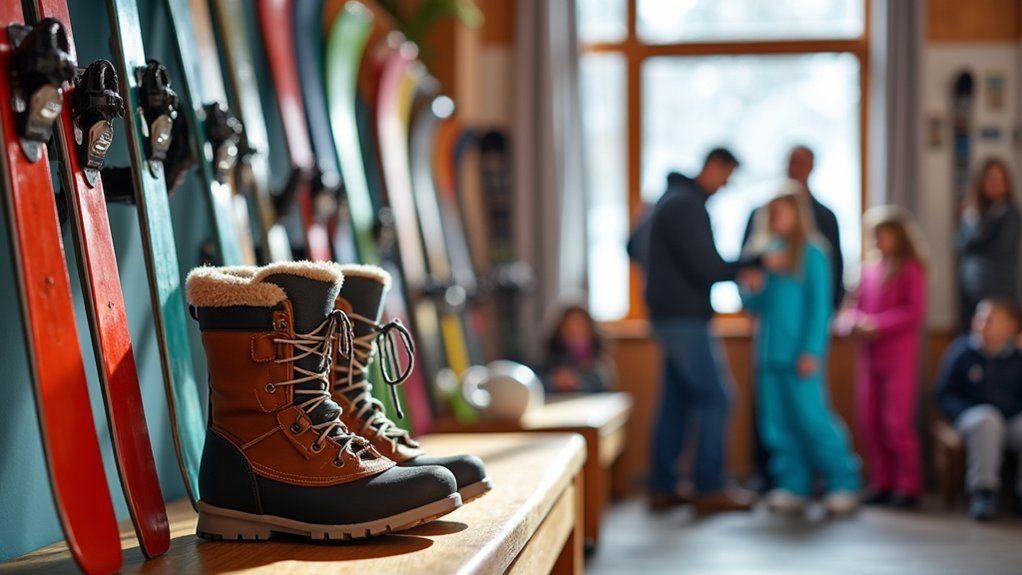



Leave a Reply